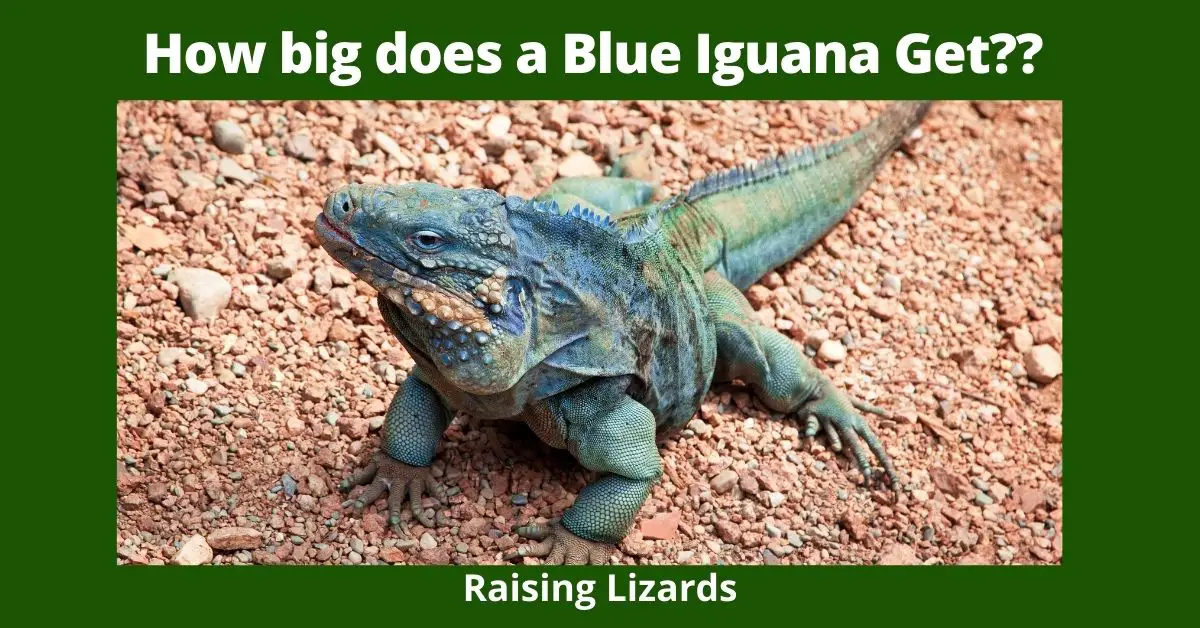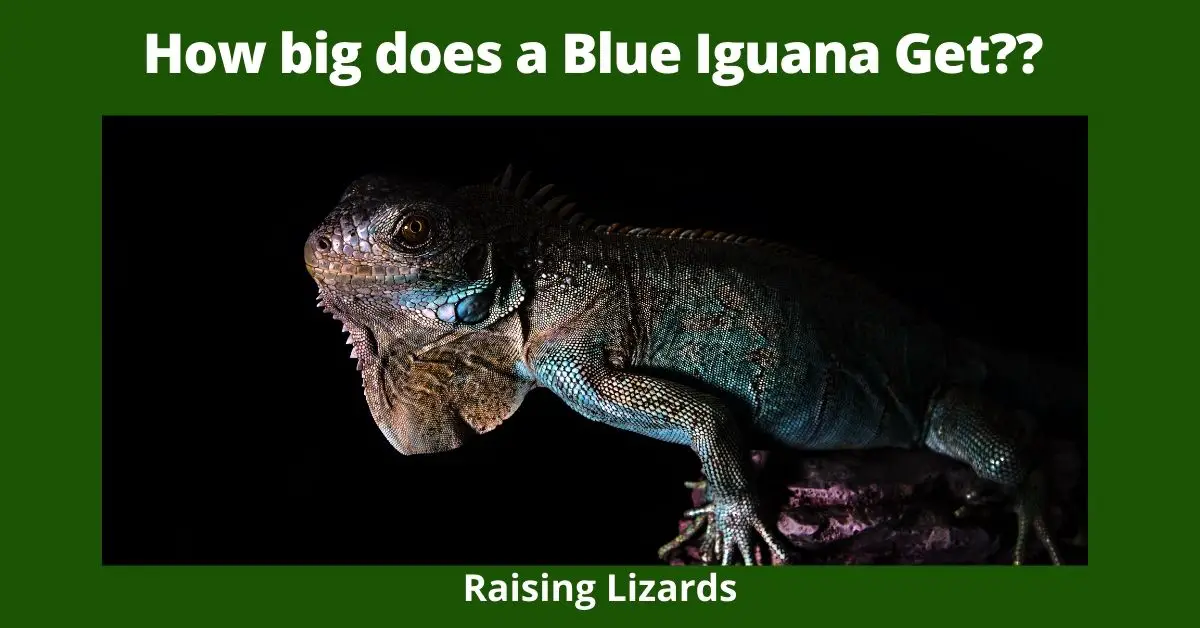Blue Iguanas grow to 5 Feet Long. Iguanas are famous for their long and bulky bodies. They can grow up to 60″ inches (1.52 m) or 5′ feet long in adulthood, with some that measure even more! Blue iguanas have a body similar length as well so they’re often called “blue tongue lizards.”
How big does a Blue Iguana Get?
Do you know how big a Blue Iguana can get? They can grow up to be quite large, around 5-6 feet long! In this blog post, we will discuss the growth of Blue Iguanas and what factors influence their size. We will also provide some interesting facts about these creatures. Jump to 7 Reasons to Have a Pet Iguana
In Nature How Big Does A Blue Iguana Get?
Blue iguanas can reach up to six feet long, and weigh up to 30 pounds. They are the largest of all the iguanas. The males are larger than the females.
Blue Iguanas have a dewlap which is a piece of skin that hangs from their neck and dangles over their chest. This helps them to regulate their body temperature.
They also have a crest of spines that run down their back, from the base of their head to the tip of their tail. This helps them to look bigger and intimidate predators or rivals.
Blue Iguanas are herbivores and eat mostly leaves, flowers, fruits, and vegetables. They live in trees and bushes where they can find food and shelter. They live in trees and bushes where they can find food and shelter
Their Bright Blue color comes from the carotenoid pigments in their food.
Where are Blue Iguanas Originally From?
Blue Iguanas are found in the wild on the Caribbean islands of Grand Cayman, Little Cayman, and Cuba. There is also a small population living in Florida. They are listed as a threatened species because their numbers have been declining due to habitat loss and hunting. Blue iguanas make great pets and there is a breeding program underway to help increase their numbers.
What is the Lifecycle of a Blue Iguana?
- Eggs – Blue iguanas lay eggs in clutches of about 12 to 15. The eggs incubate for about 85 days. They are laid in nest cavities that the female digs in sand, soil, or rock.
- Egg Mortality is High – About 50% of eggs do not hatch due to various factors such as being crushed by their parents, disease, egg-eating predators, or exposure to high or low temperatures.
- Baby Iguanas – Baby iguanas are independent and self-sufficient from the moment they hatch. They start foraging for food and water within hours of hatching.
- Hatchlings – Blue iguana hatchlings are about 15 cm (six inches) long and weigh about 25 grams (0.88 ounces). At hatching, they are dark green with some light markings on their heads. They start to change color within a few hours of hatching, becoming blue over the next few days.
- Juveniles – Juvenile blue iguanas look very similar to adults except for their smaller size and duller coloring. They reach full adult size at around two years old but may not achieve their full coloration until they are four or five years old.
- Males – Males become sexually mature when they are about three years old
- Hatchlings – Hatchlings emerge from the eggs and dig their way to the surface. They are independent of their parents from birth, and immediately start foraging for food.
- Juveniles – Juveniles are typically green with some blue markings. They grow rapidly, reaching sexual maturity within two years.
- Adults – Adults are typically a deep blue or black color, although some may be lighter shades. They can live up to 50 years in captivity.
- Natural Predators – Hawks, eagles, and owls are the primary predators of blue iguanas.
- Mating Season – The mating season is typically in late spring or early summer.

What is the Lifespan of a Blue Iguana?
- Wild – Up to 20 years in the wild
- Captive – Up to 50 years in captivity
What’s the Difference Cayman Blue Iguana Vs. Blue Axanthic Iguana
The differences are mainly in their coloring. Cayman blue iguanas are a bright turquoise color, while axanthic iguanas are a pale blue or gray.
Cayman blue iguanas also have black markings on their heads and tails, while axanthic iguanas do not.
Axanthic iguanas may also have some yellow or orange coloring on their bellies and throats, which Cayman blue iguanas typically do not have.
The biggest difference between the two is that caymans can grow up to five feet long, while axanthics top out at about three feet long.
What are Blue Iguana Sizes length and Weight?
- Infant – up to 18 inches long and up to one pound
- Juvenile – 18-24 inches long and two to four pounds
- Subadult – 24-36 inches long and five to eight pounds
- Adult – 36-48 inches long and nine to twelve pounds.
- Maximum size – a little over 58” (148 cm) from nose to tip of tail, and about 20 lbs (11 kg) in weight.
- Males are usually a little bigger than females.
- The Blue Iguana is the world’s largest lizard found on land. They are native to the island of Grand Cayman and can be seen at various tourist spots around the island. The average size is closer to 42-48 inches long and around 12 pounds but they can get as big as 58” long and close to 20
How To Encourage Blue Iguana Growth
There are a few key things you can do to help encourage healthy growth in your blue iguana. One of the most important is to make sure they have a balanced diet that includes plenty of fresh vegetables and fruits. You should also provide them with a good source of UVB light, which helps them process vitamin D and calcium.
Finally, make sure your iguana has a place to climb and explore, as this is an important part of their natural behavior. With these simple steps, you can help your blue iguana grow into a healthy and happy adult!
What is Blue Iguana cage size?
The best enclosure size for a Blue Iguana is at least 20 gallons. If you can provide a larger enclosure, that would be better. The cage should have a climbing area, such as a tree limb or something similar, and it should also have a hiding place. Be sure to provide plenty of UVB light and heat lamps to keep your iguana healthy.
What is the proper Temperature/Humidity for Blue Iguana?
Blue iguanas need a temperature range of 75-90 degrees Fahrenheit and humidity levels of 50-70 percent to be healthy. If the temperature or humidity is too low or high, your blue iguana can become sick. You can use a thermometer and hygrometer to monitor the temperature and humidity in your iguana’s habitat. Make sure to adjust the temperature and humidity levels as necessary to keep your iguana healthy.
Misting your iguana’s habitat with water can also help to increase the humidity levels. If the humidity is too low, your iguana may suffer from dehydration, respiratory problems, or skin problems. If the humidity is too high, your iguana may suffer from fungal infections or be more prone to getting sick.
Blue iguanas like to bask in the sun, so you should provide them with a place to do this. A UVB light is also important for their health and should be used to help create a proper environment for your iguana. Make sure to research what type of UVB light is best for blue iguanas before purchasing one.
A basking rock or platform should also be provided so that your iguana can get up off the ground and warm itself in the sun. Be sure to provide plenty of hiding places as well, as blue iguanas are shy animals. You can use plants, rocks, or branches to create hiding places for your iguana.
What is Nutritious Healthy Diet for Pet Blue Iguana?
The best diet for a blue iguana is one that consists mostly of fruits and vegetables, with occasional servings of lean cooked meat, live crickets, or mealworms.
Fruits – Blue iguanas enjoy a diet of mostly fruits. A good mix of favorites include:
- Apples
- Bananas
- Grapes
- Blueberries
Vegetables – In addition to fruit, iguanas also enjoy a diet of vegetables. Be sure to mix in plenty of dark leafy greens such as:
- Collard greens
- Kale
- Mustard greens
- Turnip greens
Protein – Be sure to include a good source of protein in your blue iguana’s diet. Some healthy options include:
- Cooked lean meat, such as chicken or turkey
- Live crickets or mealworms
- Wax worms (only occasionally)
Water – Iguanas need plenty of freshwaters to stay hydrated. A good way to provide this is by offering a shallow dish of water that they can drink from and also soak in.
Leaves – Iguanas love to eat leaves. Some good options include:
- Boston fern
- English ivy
- Philodendron
- Pothos vine
Flowers – Blue iguanas love to eat flowers. Some good options include:
- Chrysanthemum
- Daisy
- Geranium
- Hibiscus
- Rose
Be sure to consult with a veterinarian before making any changes to your blue iguana’s diet. They can help you create a diet that is both nutritious
Insects – Iguanas love to eat insects. Some good options include:
- Crickets
- Mealworms
- Wax worms (only occasionally)
How Often – Feed your Iguana a healthy diet two to three times a week..
How Much– an adult Iguana will eat about a half cup of food per day. Be sure to monitor your iguana intake and adjust the amount you give them accordingly.

How Much does a Blue Iguana Cost?
Pet stores sell blue iguanas for about $250
You can find cheaper blue iguanas online or from breeders.
It is important to make sure that you are getting a healthy blue
Are Blue Iguanas Endangered?
The answer to this question is not a simple one. While some populations of blue iguanas are endangered, others are not.
Blue iguanas are found in two places: the United States and the Caribbean. The US population is considered to be stable, while the Caribbean population is endangered.
There are several reasons for the endangerment of the Caribbean blue iguanas. One reason is that they are hunted for food. Another reason is that they are losing their habitat due to development.
Fred Burton Blue Iguana Recovery Program
Final Thoughts – How Big does a Blue Iguana Get?
In conclusion, blue iguanas can grow to be quite large. Five to Six feet are the adult size with the females being smaller.

